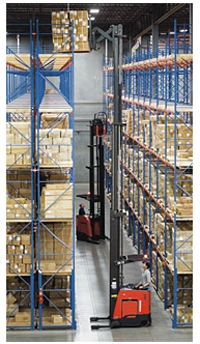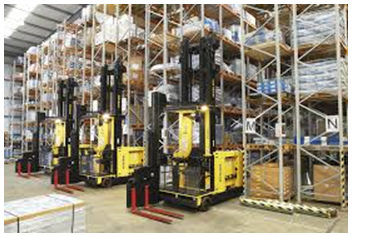Holste Says... |
 |
| When planning a storage area within an existing DC facility, in addition to storage density, the key design factors are: width of the lift truck aisles; number of pallet loads high; deployment of flexible and adaptable equipment and processing systems. |
 |
What do you say? |
 |
| Click here to send us your comments |
|
|
|
1. Conventional
Conventional single deep selective pallet rack layouts typically use aisle widths of 12 feet, and are usually no more than (4) pallets high permitting the use of standard counterbalanced fork lift trucks. To translate this into storage positions, 1,000 pallets will require about 10,500 sq. ft. of floor space. This is the most widely used configuration offering 100% access to every pallet position while including the option of picking individual case from the floor level slots. It can be deployed into any conventional warehouse having a minimum clear height of 24 feet. Utilizing a standard fork lift provides the ability to retrieve (pick) and deliver a pallet load to the shipping dock or to any other location within the warehouse. Further, equipping the trucks with computer directed RF technology enhances storage and retrieval speed and accuracy.
2. Narrow Aisle (NA)
 The NA layout utilizes a specially designed compact Reach Truck that can stack pallets (6) high while operating in an 8 ft. wide aisle. The Reach Truck is equipped with a high mast and pantograph type of reach mechanism that scissors the pallet forward from the mast. In operation, the truck turns a right angle to face the rack, and then extends the pallet load out into its proper slot. Due to the truck’s compact overall length and the fact that it carries its forks in a retracted position, it requires substantially less room to turn than does a conventional counterbalanced fork lift truck. However, due to the high mast, the reach Truck has restricted movement outside of the immediate storage area. With this storage configuration, 1,000 pallets will require about 6,000 sq. ft. of floor space. The NA layout utilizes a specially designed compact Reach Truck that can stack pallets (6) high while operating in an 8 ft. wide aisle. The Reach Truck is equipped with a high mast and pantograph type of reach mechanism that scissors the pallet forward from the mast. In operation, the truck turns a right angle to face the rack, and then extends the pallet load out into its proper slot. Due to the truck’s compact overall length and the fact that it carries its forks in a retracted position, it requires substantially less room to turn than does a conventional counterbalanced fork lift truck. However, due to the high mast, the reach Truck has restricted movement outside of the immediate storage area. With this storage configuration, 1,000 pallets will require about 6,000 sq. ft. of floor space.
A variation of this truck design is the double-reach, which uses a double pantograph mechanism to increase the length of its reach. A double-reach truck can store pallets two-deep, however requires an additional 6” of aisle width for their turns (8’-6” total). With this configuration, 1,000 pallets will require about 4,500 sq. ft. of floor space.
Note: Raising the roof over an existing storage area to accommodate high bay configurations is often a feasible and cost effective consideration, see http://rooflifters.com/ .
3. Very Narrow Aisle (VNA)
 VNA configuration requires a highly specialized rack-guided or wire-guided Swing-Reach Turret Truck. With this type of lift truck pallets can be stacked (9) high while operating in a 5’-6” wide aisle. 1,000 pallets will require about 3,200 sq. ft. of floor space. With automated operator controls, the truck can raise or lower a load while running in the aisle at *full speed. VNA configuration requires a highly specialized rack-guided or wire-guided Swing-Reach Turret Truck. With this type of lift truck pallets can be stacked (9) high while operating in a 5’-6” wide aisle. 1,000 pallets will require about 3,200 sq. ft. of floor space. With automated operator controls, the truck can raise or lower a load while running in the aisle at *full speed.
*Note: To get full benefit of VNA, the aisle floor must be “super flat” and the local fire protection code must allow for (9) high pallet load stacking heights.
All of the above storage configurations are flexible, adaptable, and scalable by simply adding or reducing operators and equipment. In addition to initial cost and productivity factors, the biggest differential is the potential for a 3X increase in pallet load storage within the same footprint.
One Size Doesn’t Fit All
Some companies, especially those serving ecommerce, employ multiple methods of storage, such as various types of shelving, racking, and mezzanines. Combining different types of storage systems is important in optimizing space utilization. However, the storage types and configurations should be selected based on product handling characteristics, movement velocity and facility considerations.
Based on Pareto theory - 80% of sales activity comes from 20% of the SKUs, and these SKUs are the fast movers within the warehouse. Typically, the next 15% of sales comes from 30% of the SKUs, which are the medium movers. The finally, 5% of sales comes from the remaining 50% of SKUs, which are the slow movers.
By separating the fast, medium, and slow moving SKUs, throughput can be increased by optimizing access to the fastest moving products. Easier access to the products that generate the most sales activity reduces time spent traveling while increasing productivity.
Fast and medium movers typically are stored in bulk storage and conventional selective pallet rack. For companies using reach trucks, fast moving SKUs can be stored in narrow aisles. Slow moving SKUs generally are stored in carousels, carton flow rack and shelving.
Companies that are moving high volumes of selective SKUs may find substantial benefits in the more highly automated storage and retrieval system (ASRS) configuration especially when integrated with a Goods-to-Person order fulfillment system, see – “Evaluating Goods-to-Person Order Fulfillment Solutions Part 1 of 2& Part 2 of 2”.
Final Thoughts
The type of storage and retrieval system and its configuration, along with the type of lift trucks deployed should all be selected based on the company’s marketing and sales strategy while taking facility constraints into considering.
Any reaction to this Expert Insight column? Send below.
Your Comments/Feedback
|